Equitable Stakeholder Engagement in a Remote World

Who will you meet?
Cities are innovating, companies are pivoting, and start-ups are growing. Like you, every urban practitioner has a remarkable story of insight and challenge from the past year.
Meet these peers and discuss the future of cities in the new Meeting of the Minds Executive Cohort Program. Replace boring virtual summits with facilitated, online, small-group discussions where you can make real connections with extraordinary, like-minded people.
If you’re feeling lost on how to work community engagement into your 2020 and 2021 plans, you’re not alone. With so much going on, and such limited interpersonal interaction, it might seem like engagement is a back-burner item. I’m here to offer an alternative perspective, give you a toolkit of simple tactics, and show the importance of continued, high quality community engagement.
At Connect the Dots, it is our mission to build better cities, towns, and neighborhoods through inclusive, insight-driven stakeholder engagement. We help community, private, and public sector partners to develop creative solutions that move projects and cities forward. Engagement is at the heart of this pursuit, which is why we are sharing our practices with you.
The Power and Opportunity of Remote Engagement: Four Values
There is no one size fits all solution to replace the face-to-face engagement which was possible up until mid-March 2020. In response to a newly remote society, we at Connect the Dots have developed a number of custom tools & methods which bring innovative, impactful, and easy to use solutions to the ongoing challenge of stakeholder engagement.
Our framework is intentionally designed to be multi-layered and robust to ensure a truly inclusive engagement process that will result in stronger buy in and trust. Every engagement process we design is different, adapted from our best practice methodology and developed with each project’s goals and each community’s needs in mind. We purposely include ways to engage people who do not have access to tech and/or who have varying levels of tech literacy. In fact, we often avoid the words ‘buy-in’ and instead use the preferred message of “build-in.”
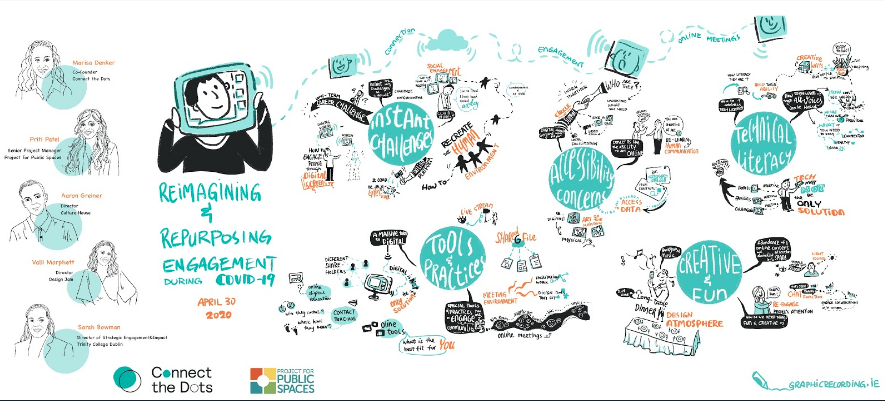
By keeping four key values in mind, you can make your remote engagement process feel genuine while you gather useful insights.
Be Creative: Creativity should inform every part of your project. It gets people excited, it helps you respond dynamically to challenges, and it can help you tailor your abilities to the appropriate audience. Your citizens will notice and appreciate a creative approach as opposed to basic, uninspired, check-the-box engagement.
Be Inclusive: Thoughtfully and intentionally map out all of your possible stakeholders for a project or process. Invite people in, and be open to diverse opinions and voices. Don’t shy away from strong opinions, and seek to understand them. Be open to a surprising new insight and make an effort to speak openly about its potential.
Act Sustainably: We mean this in terms of environmental sustainability and the sustainable longevity of a project. Whenever possible, consider long term-impacts and staying power of a decision, especially when it comes to generating the buy-in of future project users who will one day become stewards, if you do it right.
Drive with Insights: Data, feedback, observation, and statistics should be harvested in order to support each decision. Collecting insights early on will help you to mold a truly creative, inclusive, and sustainable engagement process and project. The strength of a final product will be determined by the data that support it.
Considering the Digital Divide
As we mentioned above, we’re always aware that people have differential access to public meetings, whether they be in person or remote. The top concern in 2020 is the question of the digital divide.
The digital divide can stem from several challenges:
- Internet or device cost and connection
- Tech literacy
- Language
- Visual or physical barriers
For two of these, we advise approaching these challenges the way you would at a formal public meeting, and planning accordingly: hire appropriate translators and negotiate access through a caretaker or assistance device. Just like an in-person meeting, accommodations must be made.
The added challenge comes with digital connection, and there are several options to consider: First, try to provide tech support and onboarding services for people who are new to your platform of choice. This can mean taking 30 minutes before a meeting to solve microphone problems, help people dial in, and go over the best practices for a video meeting. It can also mean spending one-on-one time for tech support over the phone or through an assistant.
Try to offer as many alternative ways of accessing the information from the meeting as possible: a hotline for one-on-one conversations, paper mailings or newsletters with information, postings at community nodes, and more (see below). Get creative!
While there is a large segment of the population without internet or computers, many people within that segment rely on their smartphones to access information, so emails and links may be useful if you are considerate of data usage (and therefore limit things like videos).
Helpful Methods
When you decide to take your engagement activities online, we encourage using tools that are functional on a wide range of devices including basic smartphones, tablets, laptops, and desktop computers. We have also developed remote but non-virtual options to bridge the digital divide. The following is a good starting point for building a toolbox of your own:
For virtual workshops and events:
- Zoom, Remo, Rume, or other video conferencing apps with breakout room and chat functions
- Mural, Miro, and other virtual workspace tools
- Connect the Dots is developing our Conversation Kit too that enables more interactive virtual workshops, discussions, and interactive communications. It’s currently being developed in collaboration with LANDAU & Bamboodev.
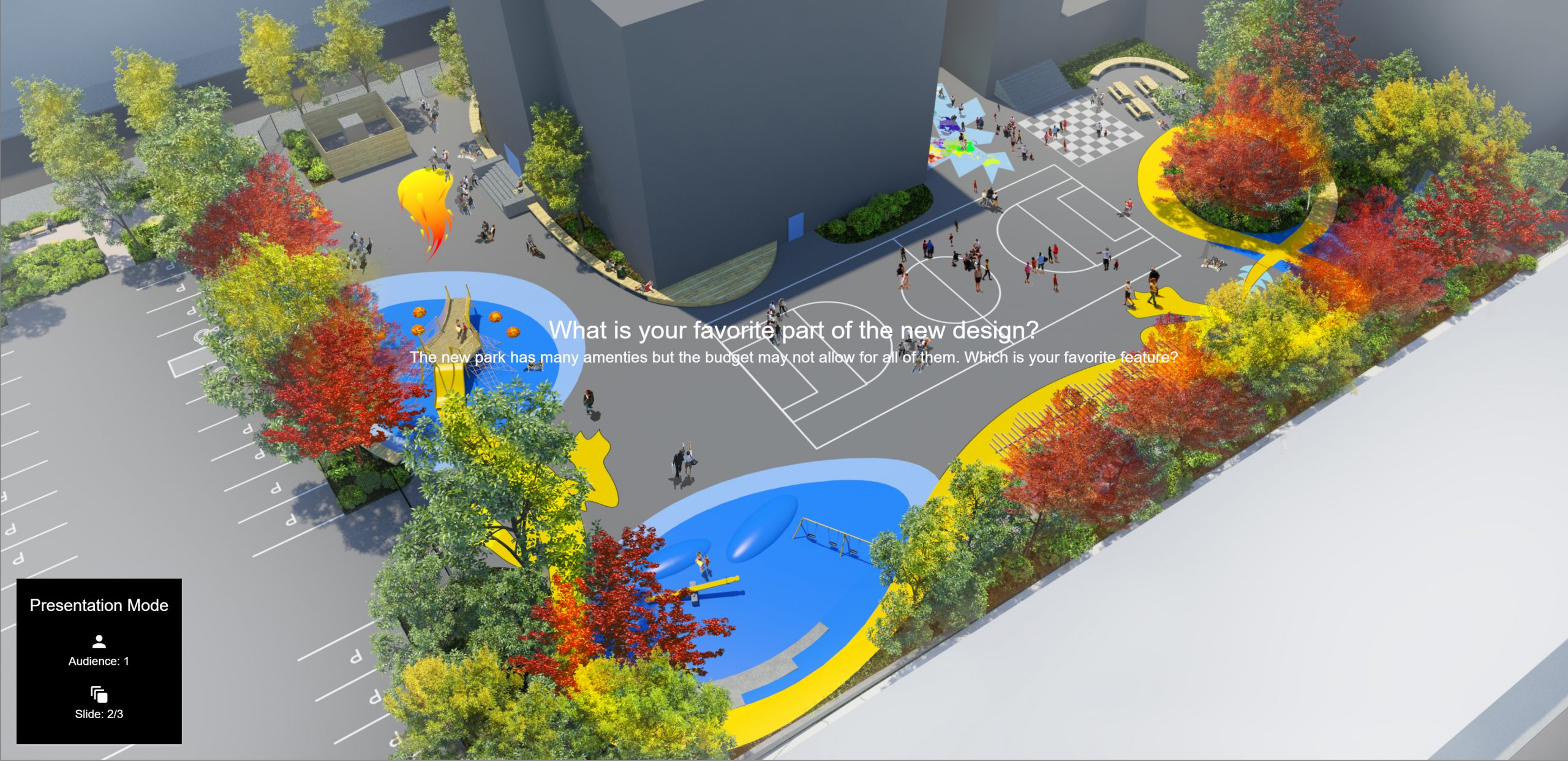

Connect the Dots’ Engage survey platform.
For virtual site tours and collaborative mapping:
- Google Tour Creator
- CoUrbanize
- Social Pinpoint
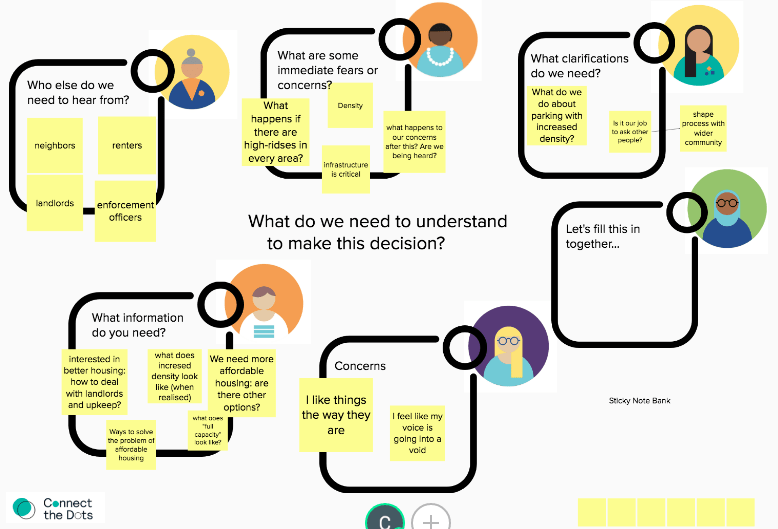
For youth-centered workshops:
- Partnerships with local schools or camps
- Partnerships with youth teams or activities
For engagement stations around the site or nearby:
- No tech necessary: practice safe social distancing if tabling
Hybrid events:
- Send out engagement kits with written or digital instructions, followed by a show and tell session
- Collaborate with artists in local parks that include a website connection
- Post at local hubs like grocery stores that include physical or online surveys
- Virtual project rooms that encourage participants to visit a physical site
- Expert facilitation and communications for two-way engagement
- Carefully designed facilitation can build trust and create a safe, inclusive and productive environment
- Open access to documentation, diagrams, guides, background information
- Webchat options for questions and queries
- Engaging communications / outreach material
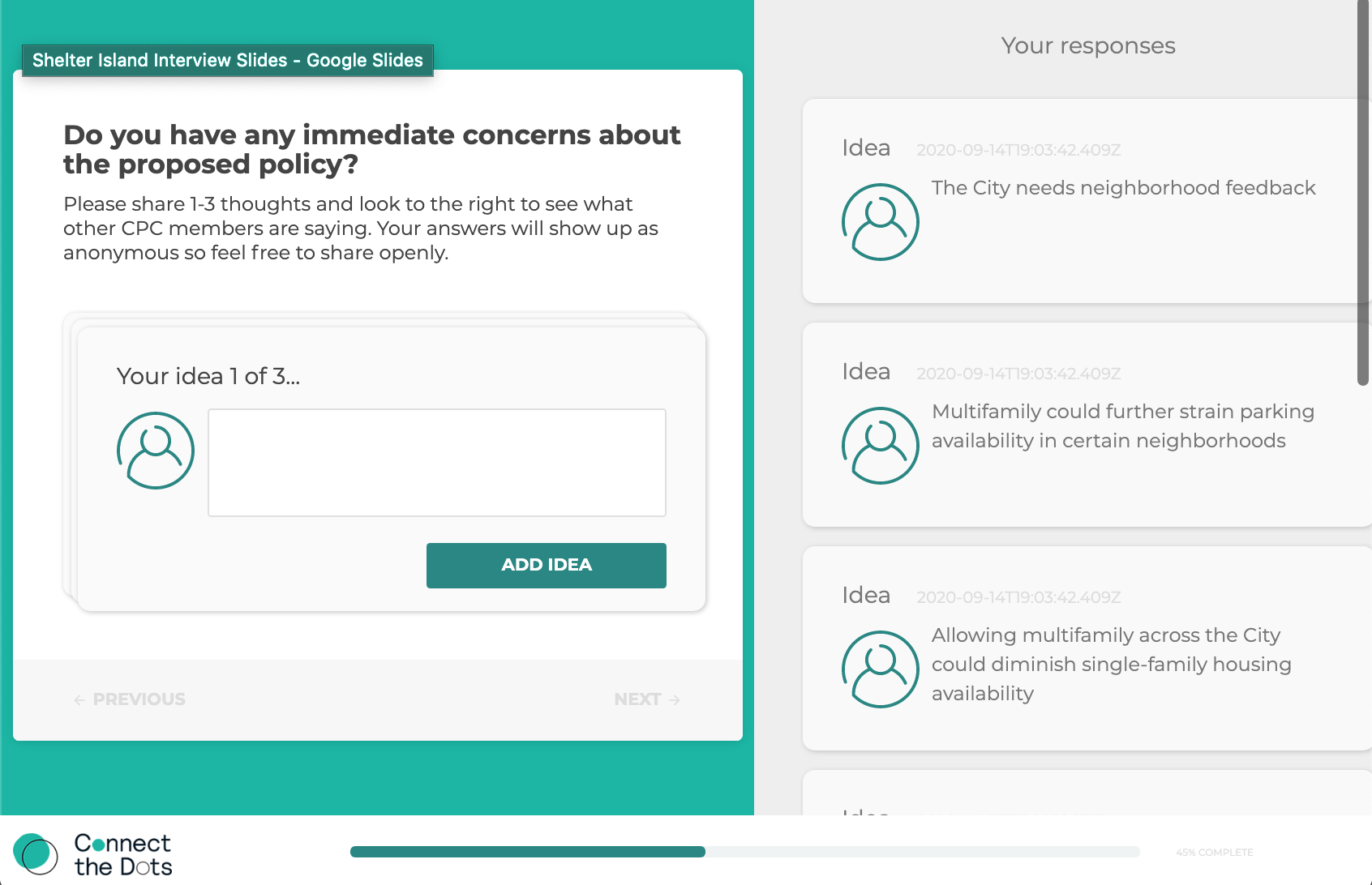
If you want to go completely non-digital or to sprinkle in analog options, here are some ideas:
- Community call-in radio show
- Ads for outreach
- Traditional 1-1 phone calls, and focus groups via phone
- Physical letters and surveys; postcard boxes in key local areas
- Key community leaders and nodes as ambassadors
- Community consultation pop up space (socially distanced engagement)
- Socially distanced picnics, playstreets, scavenger hunts (with integration of insight gathering)
And finally, some lo-fi options that don’t follow a traditional format:
- WhatsApp chat groups and Facebook Live, alongside CrowdCast
- QR codes in physical areas – creative installations driving engagement
- Phone banking, text banking (Customized text messaging at scale, via Groundsource app)
- Hybrid events such as digital dinners
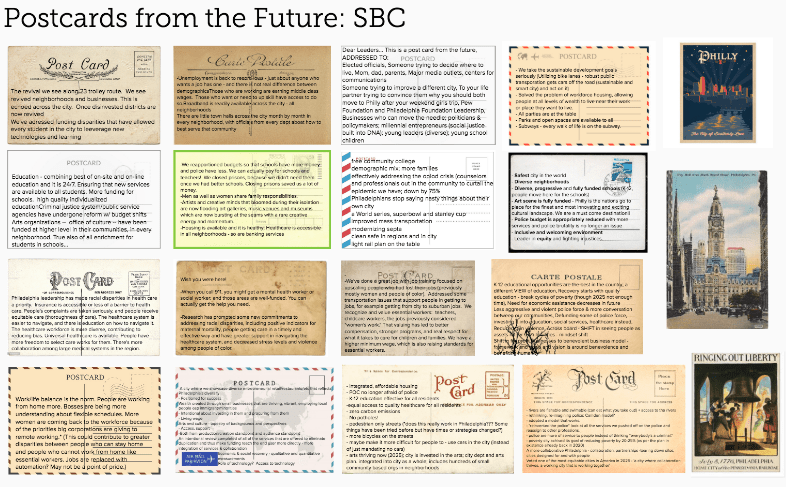
Considerations for Building your Engagement Process
Here’s a checklist you can use to make sure your engagement is worth its salt:
- Does it reach and engage with a diverse set of voices, insights, and opinions?
- Can it deliver a high-quality, enjoyable participatory experience?
- Is it accessible and adaptable?
- Is it data-driven?
- Does it represent the best you can do with your resources, or is it a watered-down version of a face-to-face experience?
- Does it manage risk and expectation rather than being simply risk-averse?
- Is it serving a direct purpose and gathering meaningful insights?
- Can you use the insights gathered to feed into the project?
- Are you the best person to handle the planning of the engagement, or do you need a third party or additional help?
- How are you shifting power and decision-making agency to those within the communities you are working in?
Valuable Lessons
In our effort to move in-person activities to remote work (a phase we lovingly refer to as “the panic pivot of March 2020”), we learned some great lessons that will continue to guide our work, and we’d like to share them with you now.
1. Remote does not simply mean virtual.
Don’t feel limited to moving every engagement event online, and don’t restrict your offerings to video calls. Use a creative mix of the tools listed above and push yourself to offer high quality content and interactive opportunities to your community. If you don’t know where to begin, start with a simple survey that asks constituents “how would you like to be engaged?”
Be dynamic, and strive for variety (without complexity): Seek a mix of virtual and non-virtual, a mix of platforms for virtual meetings, and a mix of outreach and engagement forms.
2. Engagement and Outreach should be distinct.
Too often, one-way outreach is allotted as engagement under the budget line item that should be reserved for two-way, interactive, and participatory engagement. There is a necessity for both in a public process, and the more the public can be engaged on a project that will ultimately be used by them, the better. Sometimes outreach is all you need (think of newsletters, announcements, and surveying), but true engagement requires listening, interaction, and reflection.
3. Be intentional.
However you choose to engage the public on a project, be intentional about your decisions.
- Use data and feedback to support your decisions, and be as transparent as possible when reporting your decisions back to stakeholders.
- Be intentional about equity: Co-create your process with stakeholders and allow them to inform the process from the start. Treat them as the experts they are.
- Reflect on your decisions: if you choose one platform over another because of cost, optics, because it came up first on Google, or because someone recommended it, make a note of your reasoning. If you choose to focus on outreach over engagement, be clear about why.
About Connect the Dots
Connect the Dots are experts in the design and delivery of stakeholder engagement and public consultation strategies. They work on both sides of the Atlantic (based in Dublin, Ireland and Philadelphia, PA, in the U.S.) with local and national governments and institutions and with leading infrastructure, architecture, planning and public space organizations.
The Connect the Dots team has been working intensely since mid-March to collaborate across the U.S. and Europe with thought leaders, industry innovators and their own client base to design and implement remote and online consultation tools and processes which meet the needs of clients and partner organizations. Whether assisting global media giants or local business districts, they continue to lead on effective and strategic stakeholder engagement in changing times.
Discussion
Leave your comment below, or reply to others.
Please note that this comment section is for thoughtful, on-topic discussions. Admin approval is required for all comments. Your comment may be edited if it contains grammatical errors. Low effort, self-promotional, or impolite comments will be deleted.
Read more from MeetingoftheMinds.org
Spotlighting innovations in urban sustainability and connected technology
Middle-Mile Networks: The Middleman of Internet Connectivity
The development of public, open-access middle mile infrastructure can expand internet networks closer to unserved and underserved communities while offering equal opportunity for ISPs to link cost effectively to last mile infrastructure. This strategy would connect more Americans to high-speed internet while also driving down prices by increasing competition among local ISPs.
In addition to potentially helping narrow the digital divide, middle mile infrastructure would also provide backup options for networks if one connection pathway fails, and it would help support regional economic development by connecting businesses.
Wildfire Risk Reduction: Connecting the Dots
One of the most visceral manifestations of the combined problems of urbanization and climate change are the enormous wildfires that engulf areas of the American West. Fire behavior itself is now changing. Over 120 years of well-intentioned fire suppression have created huge reserves of fuel which, when combined with warmer temperatures and drought-dried landscapes, create unstoppable fires that spread with extreme speed, jump fire-breaks, level entire towns, take lives and destroy hundreds of thousands of acres, even in landscapes that are conditioned to employ fire as part of their reproductive cycle.
ARISE-US recently held a very successful symposium, “Wildfire Risk Reduction – Connecting the Dots” for wildfire stakeholders – insurers, US Forest Service, engineers, fire awareness NGOs and others – to discuss the issues and their possible solutions. This article sets out some of the major points to emerge.
Innovating Our Way Out of Crisis
Whether deep freezes in Texas, wildfires in California, hurricanes along the Gulf Coast, or any other calamity, our innovations today will build the reliable, resilient, equitable, and prosperous grid tomorrow. Innovation, in short, combines the dream of what’s possible with the pragmatism of what’s practical. That’s the big-idea, hard-reality approach that helped transform Texas into the world’s energy powerhouse — from oil and gas to zero-emissions wind, sun, and, soon, geothermal.
It’s time to make the production and consumption of energy faster, smarter, cleaner, more resilient, and more efficient. Business leaders, political leaders, the energy sector, and savvy citizens have the power to put investment and practices in place that support a robust energy innovation ecosystem. So, saddle up.






0 Comments